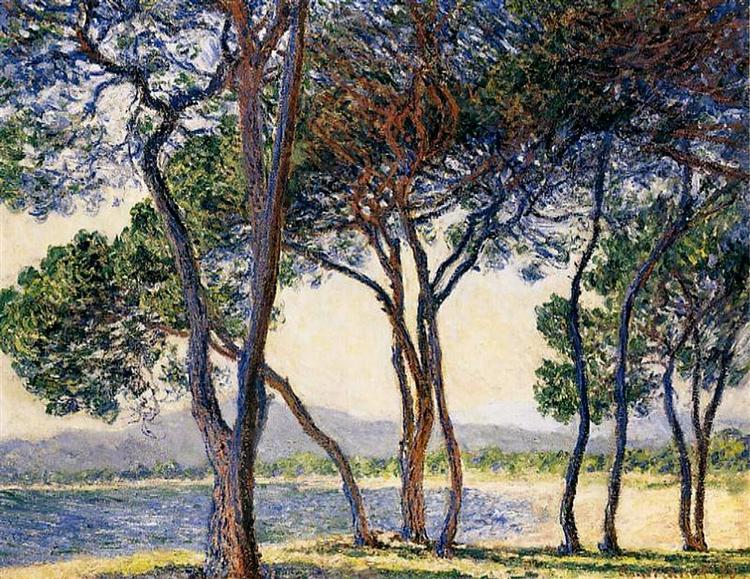Opis
Claude Monet's Trees by the Sea at Antibes (1888) presents a fascinating exploration of light, nature and man's relationship with his environment. This painting, which is at the height of his career, illustrates the Impressionist master's artistic transition towards the refined use of colour and form, recurring themes in his work, especially during his time on the Côte d'Azur.
The composition of the work is harmonious and balanced, with a predominance of greens and blues that intertwine in a visual dialogue. Monet uses vertical elements, especially in the representation of the leafy trees that stand out in the foreground, contrasting with the softness of the sea in the background. These shapes are often interpreted as a symbol of harmony between the natural and the aquatic, where the verticality of the vegetation gives the impression that it is approaching the horizon. Monet, true to his style, captures the fleeting nature of light and the movement of water, generating an almost ethereal effect.
In terms of his use of color, Monet displays a rich and vibrant palette. The radiant greens of the leaves are illuminated by the sunlight, creating a spectacle of hues that seem to vibrate before the viewer's eyes. The deeper tones of the trees suggest a shadow that contrasts dramatically with the blues and turquoises of the sea. This ability of Monet to capture light at different times of the day is the essence of Impressionism and its search for the ephemeral.
It is worth mentioning that in "Trees by the Sea at Antibes" there are no human figures that interrupt the serenity of the landscape, allowing the viewer to focus on the beauty of the natural surroundings. This decision could be interpreted as an invitation to contemplate the peace that emanates from nature, despite the background of an industrializing world that was beginning to transform rapidly in the 19th century. This absence of characters is also a characteristic feature of Monet's evolution in that period, where the landscape becomes the main subject of the work.
The context of the painting is equally significant. Monet visited Antibes in the summer of 1888, a time when the Mediterranean light and climate inspired many artists. This work is part of a series of seascapes that the artist made during his stay in the region, where he explored different aspects of light and colour. Monet had already made studies of the effects of light on water, as can be seen in his celebrated series on Water Lilies, but in Trees by the Sea at Antibes he goes a step further, integrating not only the water, but also the terrestrial environment into a cohesive whole.
In short, “Trees by the Sea at Antibes” is a testament to Claude Monet’s artistic ingenuity and his mastery in the use of color and light. The work captures a moment of sublime natural beauty and allows the viewer to immerse themselves in a visual experience that transcends time. By evoking a connection between man and nature, Monet does not merely document a landscape, but establishes an ongoing dialogue that continues to resonate throughout art history. His ability to breathe life into the landscape through brushstroke and the combination of tones has left an indelible mark on Impressionism, and this work shines as a remarkable example of his vision.
KUADROS ©, a famous painting on your wall.
Hand-made oil painting reproductions, with the quality of professional artists and the distinctive seal of KUADROS ©.
Painting reproduction service with satisfaction guarantee. If you are not completely satisfied with the replica of your painting, we will refund 100% of your money.

